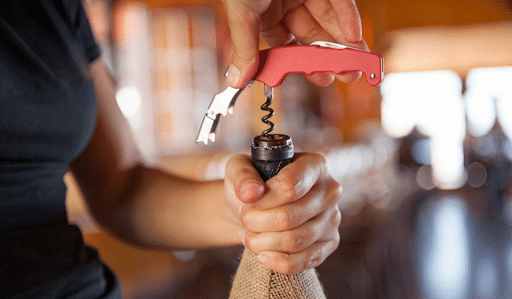Table of Contents
Few things ruin the anticipation of a good bottle of wine like struggling with a stubborn cork. Whether you’re hosting friends or winding down after a long day, the right corkscrew makes all the difference—not just in convenience, but in preserving the integrity and flavor of the wine. With so many opener styles available, it’s natural to wonder: should you use a manual corkscrew or upgrade to an electric one?
To use a corkscrew effectively, first cut and remove the foil below the lip of the bottle. Position the worm (the metal spiral) at the center of the cork, twist it in steadily, and apply even leverage to lift the cork out without breaking it. Manual corkscrews require more technique and hand control, while electric models from trusted brands like wine-n-gear.com do the work for you with the press of a button. Choosing the right tool depends on your comfort level, preferred pace, and how often you open wine—but either way, mastering the process ensures a smooth, satisfying pour every time.
What Is a Corkscrew and How Does It Work?
A corkscrew is a simple but essential tool used to extract the cork from a wine bottle. At its core, it consists of a pointed metal spiral (called a worm or helix) and a handle or mechanism that helps pull the cork out once the worm is inserted. The goal is to maintain control and extract the cork without damaging it—or the wine.
The key to successful cork removal lies in centering the worm, maintaining steady pressure, and using proper leverage. Whether manual or electric, every corkscrew follows this basic principle: twist in, pull out.
Types of Corkscrews: A Quick Overview

Choosing the right corkscrew starts with understanding the different styles available. Each type has its own mechanism, level of effort required, and ideal use case. Whether you prefer a traditional, hands-on experience or want a tool that takes care of the work for you, there’s a corkscrew designed to match your needs.
Manual Corkscrews
Manual corkscrews are the most common and widely used, often favored for their reliability and simplicity. While they require some degree of technique and strength, many wine lovers enjoy the tactile ritual they provide.
Waiter’s Corkscrew (Wine Key)
Compact, foldable, and multifunctional, the waiter’s corkscrew—also known as a wine key—is a staple in restaurants and among sommeliers. It includes a small foil-cutting knife, a metal worm, and a double-hinged fulcrum that allows for smoother leverage during cork removal. Its portability makes it ideal for travel, picnics, or anyone who wants a slim, pocket-sized tool.
Wing Corkscrew
Easily recognizable by its two “wings” that rise as you twist the worm into the cork, this user-friendly opener is perfect for beginners. Once the wings are fully extended, simply press them down to lift the cork out of the bottle. It’s a great choice for casual wine drinkers who want a straightforward and intuitive method without too much effort.
Twist-and-Pull (T-Handle)
This is the most basic corkscrew design—a simple T-shaped handle attached to a spiral worm. To use it, insert the worm into the cork and pull straight up using only your arm strength. While minimalistic and inexpensive, it can be tricky to use on older or tightly sealed bottles, making it better suited for those comfortable with a little elbow grease.
Lever-Style Corkscrew (Rabbit Opener)
Known for its sleek mechanism and smooth action, the lever-style corkscrew—often branded as a “rabbit” opener—uses a clamp to grip the neck of the bottle and a lever to drive the worm in and pull the cork out in one fluid motion. This type offers a polished, almost theatrical feel and is ideal for those who frequently open wine or want a premium, ergonomic experience.
Electric Wine Openers
Electric corkscrews are designed for simplicity and speed. With motorized extraction and minimal manual input, they’re ideal for users who want a stress-free way to open wine—especially those with limited hand strength or arthritis.
Push-Button Electric Corkscrew
This fully automated model makes opening a wine bottle as simple as pushing a button. Once positioned over the cork, the opener drives the worm in, removes the cork, and often includes a second button to eject it. Many models come with integrated LED lights and foil cutters, making them both practical and visually appealing for home entertaining.
Rechargeable or Battery-Operated Units
These devices offer all the convenience of a push-button model but are powered by either built-in rechargeable batteries or replaceable ones. They are perfect for frequent wine drinkers or for events where opening multiple bottles is common. Compact storage bases often include charging docks, foil cutters, and even bottle stoppers, turning them into all-in-one wine stations.
By understanding the different types of corkscrews, you can choose a tool that fits your lifestyle, grip strength, and wine-drinking habits. Whether you’re after a traditional experience or modern ease, the right corkscrew turns bottle opening from a chore into part of the enjoyment.
How to Use a Manual Corkscrew (Step-by-Step Instructions)
Using a manual corkscrew can feel intimidating at first, but once you understand the rhythm and technique, it becomes second nature. Whether you’re using a classic waiter’s corkscrew, a winged opener, or a lever-style model, the basic process remains the same: control, precision, and steady movement.
Step 1: Cut the Foil Below the Bottle Lip
Start by removing the protective foil that covers the cork. If you’re using a waiter’s corkscrew, unfold the small blade and make a smooth horizontal cut just below the raised lip of the bottle’s neck. Rotate the bottle or the blade to create a clean circle, then peel off the foil top. Alternatively, a dedicated foil cutter can be used for a cleaner and faster result. Removing the foil below the lip ensures the wine doesn’t come into contact with any leftover material and allows the corkscrew to sit flush on the top.
Step 2: Position and Center the Worm
Hold the bottle firmly on a flat surface with one hand. With the other hand, place the sharp tip of the worm directly in the center of the cork. This is essential for balance and proper grip during extraction. Press down slightly to anchor the point before beginning to twist.
Step 3: Twist the Worm into the Cork
Slowly rotate the corkscrew clockwise, applying gentle downward pressure as the worm drills into the cork. Stop once about one spiral remains visible above the cork. Going too far risks piercing through the bottom of the cork, which can cause bits of it to fall into the wine.
Step 4: Apply Leverage and Pull the Cork Out
Depending on the corkscrew type, this step varies:
- Waiter’s Corkscrew: Use the double-hinged lever to brace against the lip of the bottle. Pull up slowly in two stages using the notched hinge to apply steady, increasing force.
- Wing Corkscrew: As you twist, the wings will rise. Once fully extended, press them down simultaneously to lift the cork.
- Lever-Style (Rabbit): Clamp the handles onto the bottle neck, then pull the lever up and down in one motion to remove the cork.
Always use slow, even movements—rushing or twisting sideways increases the chance of breaking the cork.
Step 5: Remove the Cork from the Worm
Once the cork is out of the bottle, grip it gently and twist it off the worm by hand. For tighter corks, reverse the motion slightly or use a bit of extra pressure. Be careful not to bend the worm or strip the cork.
Pro Tip:
Keep the bottle steady by placing it on a table or countertop. If you hold it in your lap or at an angle, you risk applying uneven force and breaking the cork. Practice improves your technique—and makes for smoother, cleaner cork extractions every time.
How to Use an Electric Wine Opener (Step-by-Step Instructions)

Electric wine openers are designed to simplify the bottle-opening process, especially for those who want speed, ease, and minimal physical effort. Whether you’re preparing for a dinner party or enjoying a quiet night in, here’s how to use an electric corkscrew correctly from start to finish:
Step 1: Charge the Opener or Insert Fresh Batteries
Before using your electric wine opener, make sure it’s fully charged or equipped with fresh batteries. Most models will include an indicator light that tells you when the device is ready. If it’s rechargeable, place it on its charging base and allow it to charge fully—usually a few hours depending on the model.
Step 2: Cut and Remove the Foil
Use the built-in foil cutter, often attached to the base or provided as a separate accessory. Place it on the top of the bottle, squeeze gently, and rotate it to make a clean cut just below the bottle’s lip. Remove the foil to expose the cork. A clean foil cut helps the opener center properly and avoids jamming during use.
Step 3: Align the Opener with the Cork
Center the electric opener directly above the cork and make sure the bottle is on a flat, steady surface. Hold the bottle firmly with one hand while positioning the opener vertically with the other. Proper alignment ensures the worm enters the cork cleanly and avoids slanting or tearing.
Step 4: Press the Button and Let It Work
Once positioned, press and hold the down or “cork removal” button. The worm will automatically rotate, drill into the cork, and continue turning until the cork is fully extracted. There’s no need to pull or twist—the device handles it for you. Most openers will stop automatically once the cork is removed from the bottle.
Step 5: Release the Cork from the Opener
After the cork has been extracted, hold the opener away from the bottle and press the eject or reverse button. This will reverse the motor and push the cork off the worm, allowing for clean removal. Be sure to dispose of or store the cork properly depending on whether you plan to finish or reseal the wine.
Troubleshooting Tips
- Cork Stuck Inside the Device? Gently remove the opener from the bottle and press the reverse button while holding the device at a slight angle. Avoid forcing the cork out with your fingers, as this could damage the worm.
- Opener Not Responding? Check the battery or charging status and ensure the worm isn’t blocked by leftover cork fragments.
- Cork Only Partially Extracted? Remove the opener, check alignment, and try again. Misaligned devices may only remove part of the cork before jamming.
Manual vs. Electric Corkscrews: Which Is Better?

Choosing between a manual and electric corkscrew depends on your personal preferences, physical comfort, and how often you open wine. Each type offers distinct pros and cons, from speed and convenience to cost and durability. Here’s how they compare across the key factors that matter most:
Ease of Use
- Manual Corkscrew:
Manual corkscrews require some hand strength, coordination, and a bit of practice—especially when using a waiter’s corkscrew or T-handle opener. While they provide a hands-on, traditional feel, they may be challenging for individuals with limited grip or mobility.
- Electric Corkscrew:
Electric models are significantly easier to use. With the press of a button, the cork is extracted effortlessly—making them ideal for beginners, older adults, and anyone with arthritis or wrist issues. There’s virtually no learning curve, which makes them great for casual wine drinkers or those opening multiple bottles at events.
Speed and Efficiency
- Manual Corkscrew:
Using a manual opener takes a bit more time, especially if you’re aiming for precision. That said, experienced users can open a bottle in under 30 seconds and often enjoy the ritual and control it offers.
- Electric Corkscrew:
Electric openers are faster and more efficient by design. Most can remove a cork in 5 to 10 seconds with no physical effort required. For parties or frequent use, the speed advantage adds up quickly.
Maintenance and Durability
- Manual Corkscrew:
Manual tools tend to be more durable over time because they have fewer moving parts. A quality wine key or lever-style opener can last for decades with minimal care. Occasional cleaning is usually all that’s needed.
- Electric Corkscrew:
Electric corkscrews require a power source, either via batteries or a rechargeable base. Internal motors and circuitry can wear out with heavy use. Some models also require routine charging or battery replacement, which may not suit infrequent users.
Price and Value
- Manual Corkscrew:
Manual corkscrews are generally more affordable, with solid options starting as low as $5. High-end models with ergonomic designs or premium materials typically range between $20 and $50.
- Electric Corkscrew:
Electric openers are typically priced between $25 and $80 depending on the brand, features, and included accessories like foil cutters, chargers, or display stands. While the upfront cost is higher, the convenience factor may justify the investment for many.
Which One Is Right for You?
- Choose manual if you value tradition, portability, and long-term durability.
- Opt for electric if you want speed, ease of use, and minimal physical effort.
Both tools can open wine effectively—the key is selecting the corkscrew that fits your lifestyle, skill level, and how much ritual you want in the process.
Choosing the Right Corkscrew for Your Needs

Not all corkscrews are created equal, and the best one for you depends on how often you open wine, your physical comfort, and even your lifestyle. Here’s a quick guide to help you match the right tool to your situation:
- Occasional Drinker: A wing corkscrew or basic waiter’s wine key offers a good mix of simplicity, affordability, and ease of use. It’s reliable and doesn’t take up much space.
- Entertainer or Host: If you’re opening multiple bottles during parties or dinners, an electric corkscrew can save time and effort—plus it adds a modern, polished touch to your hosting routine.
- Gift Buyer: Shopping for a wine lover? Lever-style corkscrews or high-end electric models make stylish, functional gifts that feel premium and practical.
- Frequent Traveler: A compact, foldable wine key fits easily into a bag or picnic tote and doesn’t rely on batteries or charging. Ideal for travel, outdoor events, and on-the-go sipping.
- Limited Grip Strength or Arthritis: Electric openers are a game-changer for those with reduced hand strength or mobility issues. They reduce strain and provide consistent results with minimal effort.
Common Mistakes When Using a Corkscrew (And How to Avoid Them)
Opening wine seems straightforward—until something goes wrong. These common mistakes can lead to broken corks, spilled wine, or damaged tools. Here’s what to watch for:
- Off-Center Insertion: Starting the worm too far from the center can cause it to dig in at an angle, increasing the chance of cork breakage or misalignment.
- Over-Twisting the Worm: Drilling all the way through the cork may push pieces into the wine, compromising taste and clarity.
- Rough or Sudden Extraction: Yanking or twisting too aggressively can cause splashes, broken corks, or even a cracked bottle neck.
- Skipping Foil Removal: Attempting to open a bottle with the foil intact can dull your tool or allow bits of metal or plastic to fall into your glass.
Tip: Always open bottles on a stable surface and proceed with calm, steady movements. Mastery comes with practice.
Open Your Wine Like a Pro
A corkscrew might be a small tool, but using the right one can elevate your wine experience from frustrating to effortless. Whether you prefer the craftsmanship of a manual opener or the convenience of an electric model, success comes down to technique, control, and confidence.
Opening a bottle isn’t just a step toward drinking—it’s part of the ritual. And when done right, it sets the tone for everything that follows. With the right corkscrew in hand, every pour starts smoothly and every sip feels just a little more refined.
